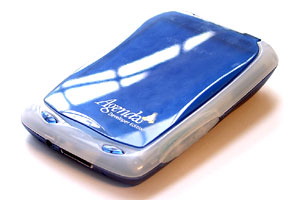 |
Given:
Completion
 |
- RS-232 cable
- Headphones with microphone
- Stylus
- Cradle
- Cover leatherette black
- CD with software
Solutions:
Features
To ensure proper performance of the operating system in the AGENDA 32-bit NEC VR4181 MIPS-processor with a frequency of 66MHz. However, it is not too good to perform its duties, but more on that later. On the amount of memory you can say is that everywhere indicate quite different data. At AgendaVR3 Developers Edition, which are sent to developers since last autumn, was found 8 MB Flash and 8MB of ROM. About the final version of AGENDA, which went on sale in the surveys of Western magazine reported 8MB Flash and 16MB of ROM. Site Agenda Computing says 16MB Flash and 16MB of ROM. And at the same time, the forum is one of the company's representatives stated that "working to increase the Flash-memory to 16MB underway, but likely only the next version AgendaVR3r will have a memory of this size." Who here believe, if even within the company has no information about it? Probably have to wait for reviews of those who ordered a new AGENDA. One thing is certain: thanks to the fact that all data is stored in the flash-memory, they will not be lost when removing the batteries. On the amount of memory you can say is that everywhere indicate quite different data. At AgendaVR3 Developers Edition, which are sent to developers since last autumn, was found 8 MB Flash and 8MB of ROM. About the final version of AGENDA, which went on sale in the surveys of Western magazine reported 8MB Flash and 16MB of ROM. Site Agenda Computing says 16MB Flash and 16MB of ROM. And at the same time, the forum is one of the company's representatives stated that "working to increase the Flash-memory to 16MB underway, but likely only the next version AgendaVR3r will have a memory of this size." Who here believe, if even within the company has no information about it? Probably have to wait for reviews of those who ordered a new AGENDA. One thing is certain: thanks to the fact that all data is stored in the flash-memory, they will not be lost when removing the batteries. In size AGENDA is not much different from the Palm V. Linear dimensions are: 11,5 x7, 6x2 cm Weight: 115 gr. In his hand is quite comfortable, but here's a button to press is not always convenient, however, get used to it after a few days of use. But the screen width is comparable with the most screen Palm m100. Permission had 160h240, monochrome with 16 shades of gray. Backlight bright enough, but, unfortunately, is inverted.Governing Body: 7 function keys, as well as 7 silk-touch buttons for launching major programs, menus and the onscreen keyboard.
During the dark red window hid IrDA-port, as well as something called the developers Consumer IR port. This port has a more powerful transmitter, it will use the AGENDA as a universal remote control and its "range" is 10 meters. Developers Edition version has not, so check this information failed.
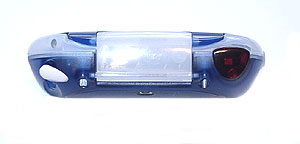 |
 |
Used to alert the two-color LED (red and green) and simple "beeper." The loudness of sound can hardly argue with the loudspeaker Handera 330, but any Palm it "perepischit.
Hardware
The body is made of plastic. As for the quality it might not be the best, but the scratches on it almost invisible. The site can be ordered AGENDA three different colors: Matrix (black), Shark (blue) and H20 (colorless, transparent).The screen protects the flap to hinge on a design very similar to the m100. It can not remove.
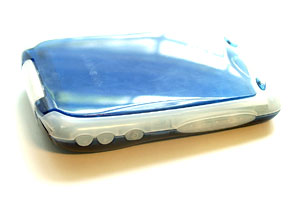 |
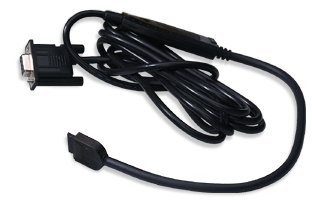 |
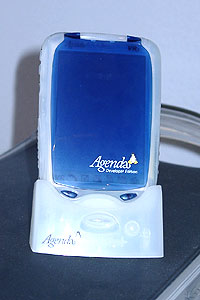 |
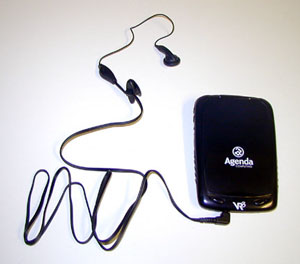 |
Pocket Linux. Part 2
Operating System
As the OSes used by Linux-based kernel 2.4 for MIPS-processor. For such a small device it is hard, "clean" AGENDA seriously retarding. Everything is simple, just need to update the firmware and everything immediately starts working much faster. Compared with the first version of software for AGENDA occurred very significant increase in speed and stability. We even managed to reduce energy consumption. AGENDA now works about as well as black and white Palm'y.Two weeks of active use in alkaline batteries and about a week on batteries - quite a decent result for a PDA with a processor twice as powerful than any PalmOS-devices, and much more ponderous OS.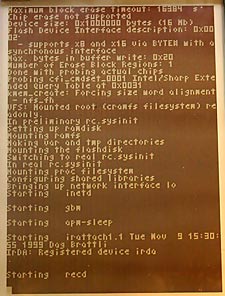 |
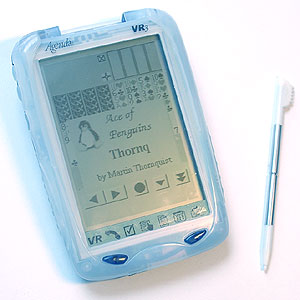 |
Firmware
On the AGENDA you will find a standard set of applications for PDAs. Names entirely speaking: Schedule, To-Do, Address, Notes, Expenses, WorldClock, Calculator, Find ... Several classic games: VR-Tris, Freecell, Bomb, Checkers, Merlin, Solitaire, ThornQ. Besides them there are system utilities Power, DateTime, Network, Quicksync, Statusbar, Console Terminal, Contrast. |
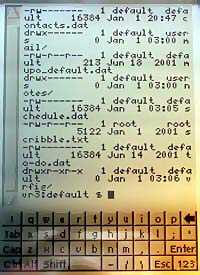 |
Other programs
If all of the above you are not scared, you're ready for what will happen next.For any new platform is usually sharply question the availability of software. Do AGENDA solves this problem by the possibility of relatively easy to port to the "big" Linux. Some programs are simple enough to be recompiled. To do this you need to take a ftp-server suite of programs, set up a cross-compiler and understand instructions for beginners.
 |
Development of core and application systems is leaps and bounds, on average two to three times a month a new version, and each of them brings something new. The main "horse" all * NIX-systems is the work of the network. Not surprisingly, the Apache Web server has been ported to one of the first. Again, the practical value is questionable (idea how to slow down a server?), But showed that the AGENDA and it can. But the bulk are useful operating time. Appeared IRC-client, repeatedly discussed the transfer of a known mailer mutt and other popular applications. "Light" BlackBox window manager has been successfully ported and is now undergoing closed testing. Also moved popular editors VIM and Emacs. The entire list of programs give here does not make sense. What is not now appear in the near future, this can be no doubt. Float to the surface and even more interesting projects. For example, the project SNOW. This is a new set of tools for processor MIPS (to be precise, this ABI - Application Binary Interface). It optimizes the download and use a common (shared) libraries. This increases performance through better use of limited resources of the CCP. When the firmware SNOW-kernel, you must recompile all the programs are used. This is not a problem, because the source of almost all programs AGENDA is available for download. In a pinch, you can always ask the developer to go to a meeting and you do it yourself. The reason why SNOW not become the de facto standard, with all its benefits, is this: libraries need to be rigidly tied to addresses in the device (it is necessary that the two libraries did not occupy the same address). Therefore, if at least one of them is added, removed, upgraded, we have to tie all the programs again. For a desktop computer that would not be acceptable, but the PDA is still not too much zapishesh. So if you're using the same set of libraries (and applications) and do not update it too often, then you should try this "snowball". A substantial increase in speed is worth it. Especially, if the creators SNOW see interest in his offspring, then they have fulfilled their promise to create a method of automatic addressing, which will eliminate the procedure to be recompiled.
Problems
Recent kernels have the same problem, the cause of which still can not find. It is associated with activation of "hibernation." If AGENDA off (after pressing the Power, inserting the stylus into the slot, or if she does not enjoy a few minutes) then after 3-5 minutes it can no longer be included. In general. Necessary to press Reset, wait for loading the OS, re-calibrate the screen. Despite the fact that the root cause of this problem found so far have failed to solve it is still possible. It needs to patch the kernel patch, which in principle is perfect for another. Namely, in order to be able to manage two signal LEDs from the console. Is not clear how these are related system calls, but the fact that it really helps. Oh and one more trouble - on the AGENDA, which was in testing, constantly discharged time, counting from 01.01.1970. It appears that this flaw only this specific sample, because no one else with such problems are not addressed in the help desk.Conclusion
Apparently, Agenda VR3 does not become an evolutionary dead-end PDAs. In late June - early July appears Agenda VR3r - it will have a built-in battery, most likely Li-Ion. At conferences and exhibitions devoted to Linux, was presented Agenda VR5, but its fate is not known yet. It has a metal casing, built-in rechargeable battery, more powerful processor, more memory, etc.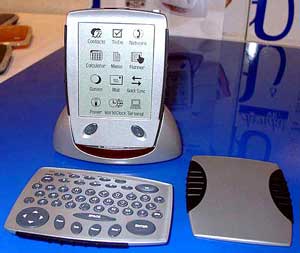 |
On the site you can order some accessories, such as a modem for $ 99 or adapter RS232-USB. The future is promised to sell the keyboard for $ 60 (that's really, really, a necessary addition), and there will be free to download new programs, including games, scientific calculator, etc.
Generally, the site Agenda lot of things promised, but that's not clear when these promises will be fulfilled. Yes, and its content leaves much to be desired. Find there something useful it is almost impossible for all necessary data or need to go to a page for developers, or the ftp-server of the company. Here are just there and you can find the links, files, detailed (but not too understandable for beginners) documentation. The one who searches always finds. That's just not all they want. If you decide to buy AGENDA, you do not have to spend hours reading message boards or look around the internet the answer to your question. The device, which you get, everything will work, and work normally. You can leave everything "as is" and install only the release-or stable-versions of new programs as they become available. With a 95% probability everything will be fast, stable and will not cause you any problems. This percentage you will provide an army of developers and beta testers, who will carefully examine all the details and nuances of (doing something after all and for myself too). But maybe you want to be on the crest of the open-source-wave, put all the versions of programs, ranging from alpha, to upgrade the kernel as soon as a new version of firmware? Well, suppose you would not be a surprise that it is necessary to communicate on IRC with developers who regularly attend forums for users to share experiences and report bugs. But you can ask the creator of the program on the necessary functions, or help him, able to write the appropriate module. Translated into Russian interface and help files, even just promptly report any bug - it's always appreciated. Needless to say, the Linux-community is one big plus - cohesion. This helps to achieve the goals, although there are always people who do not accept this approach. Just understand that the important thing is choice. If you feel that this is exactly what you need, Agenda VR3 you did not disappoint. If you do not lie to this soul - well, choose something else, enough alternatives. But I warn you, you'll miss the most fun and interesting! If after reading this article, you came to buy AGENDA obsession, the only thing you can help, it is urgent order it online AgendaComputing. It costs $ 249 and another for $ 59 UPS will deliver it directly to your home. So go for it!
And, you know what this AGENDA? This is the best gift a fan of Linux, with no options. Specifications are authors, translation:
Oleg Kurapov